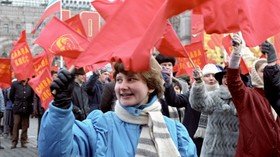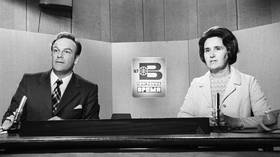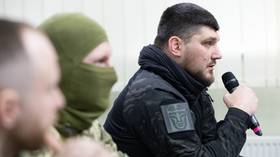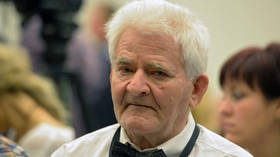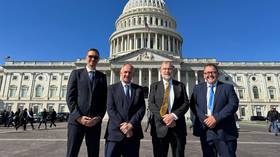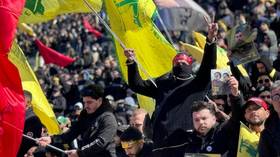The plot to kill off the Soviet Union
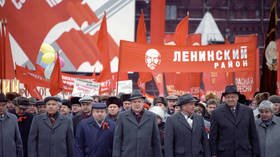
The collapse of the Soviet Union is frequently seen as small nations gaining independence from Russia. In reality, the events of 30 years ago were very different, with Russia playing a leading role in the dismantling of the USSR.
On December 7, 1991, three decades ago this week, the heads of Soviet republics of Russia, Ukraine, and Belorussia (nowadays Belarus) – Boris Yeltsin, Leonid Kravchuk, and Stanislav Shushkevich – met at a hunting resort in the Belorussian forest of Belavezha. The next day they signed an accord, effectively dissolving the USSR.
For some, this was a heroic move that ensured the final defeat of communism, rid Russia of its imperial heritage, and at last gave independence to the long-suffering nations of the Soviet Union. For others, though, it was a betrayal that needlessly shattered a union that most citizens still cherished, and that left millions of Russians living outside their own country, laying the seeds of future conflicts, such as the war today in eastern Ukraine.
Destroying the USSR wasn’t on Shushkevich’s mind when he invited his Russian and Ukrainian colleagues to Belavezha in December 1991. Rather, he was hoping to solve the energy crisis faced by his Belorussian Soviet Socialist Republic. The Soviet economy had relied on the guiding hand of the Communist Party of the Soviet Union. When the latter’s power collapsed as a result of Soviet leader Mikhail Gorbachev’s perestroika reform program, the centrally-planned economy fell into chaos. Shushkevich was worried about shortages of supplies of oil and gas for the winter, and asked the Russians and Ukrainians to come to Belavezha to discuss common efforts to solve their economic problems.
Once the meeting began, however, Russian representative Gennady Burbulis came up with the unexpected proposal that the leaders sign a statement to the effect that “the USSR as a geopolitical reality and a subject of international law ends its existence.” The Belorussians and Ukrainians agreed, and thus the Belavezha Accord was signed, declaring the 1922 Treaty on the Creation of the Soviet Union null and void. With this act, the USSR was dissolved.
Two things stand out in all this. First, the other republics in the Union were not consulted about whether they wanted it to be destroyed or not. Republics like Kazakhstan and Uzbekistan were not asking for independence, but they had it forced on them whether they wanted it or not.
Second, the party that took the initiative in destroying the Union was Russia. The Soviet Union could have survived without the three Baltic states – Estonia, Latvia, and Lithuania – which had declared independence in August 1991. It could even perhaps have survived without Ukraine, which held a referendum on independence just six days before the Belavezha meeting. But it couldn’t survive without Russia. Once Russia decided it didn’t want to be part of the Union, the USSR was doomed.
Why then did Russia’s leaders decide to cut their republic off from the others in the USSR, most of which they had been united with for well over a hundred years, and in many cases much longer, and which in some instances contained large Russian populations? The answer lies in the political and ideological ambitions of Russia’s president, Boris Yeltsin, and his liberal allies.
When Gorbachev launched perestroika in 1985, Russia’s intelligentsia mostly supported him. By 1989, however, many felt that the Soviet leader was not going far enough, fast enough. When Boris Yeltsin set himself up as a rival to Gorbachev, many switched their allegiance to him, seeing Yeltsin as someone more likely to enact rapid democratic and free market reform.
Gorbachev controlled all the levers of power at the level of the Soviet government. Yeltsin decided to outflank him by gaining control of the Russian Soviet Federative Socialist Republic (RSFSR), the largest of the 15 republics that made up the USSR. Once Yeltsin won election in 1991 to the post of president of the RSFSR, he and his supporters began promoting a form of Russian nationalism, and demanded that power be devolved from the all-Union level to that of the Russian republic – i.e. from Gorbachev to Yeltsin.
Most notably, in spring 1990, the RSFSR Congress of People’s Deputies issued a ‘Declaration of State Sovereignty’. This announced the superiority of Russian law over Soviet law and declared that any acts of the Soviet government that were contrary to the rights of the RSFSR were illegal. The Declaration sparked what became known as the ‘parade of sovereignties’, whereby the other republics in the USSR followed suit. But it was Russia that led the way, largely to suit the desires of Yeltsin and his backers.
Once the Soviet Union was no more, Gorbachev no longer had a role. Destroying the USSR therefore served Yeltsin’s personal interests in enabling him finally to defeat his rival. It is this that in part explains why Russia prompted the Belavezha Accords.
There was another reason, as pointed out by Yeltsin’s chief financial adviser, Yegor Gaidar. As deputy prime minister of Russia in early 1992, Gaidar would become famous as the architect of a program of radical free market reform known as ‘shock therapy’. He and his team were keen to introduce shock therapy even before then. However, as Gaidar later explained, they did not believe that the leaders of the other Soviet republics were willing to do the same.
Since economic reform in the USSR had to be carried out simultaneously in all republics, the opposition of the non-Russian republics meant that shock therapy was impossible as long as the USSR remained in existence. The only way Russia could carry it out was to get rid of the other republics and become an independent state. In short, the choice was the Union or shock therapy. Yeltsin and Gaidar chose the latter.
Arguably, the Union in its existing form was doomed anyway. The Communist Party was so central to the management of the country that once it was undermined, the USSR rapidly unraveled, forcing local authorities to gather power into their own hands in a desperate effort to maintain some form of order. Still, some form of Union could possibly have been retained had the will to do so existed in Moscow.
It didn’t. The continued existence of the USSR didn’t suit the interests of Yeltsin and those around him, and so they happily got rid of it. For better or for worse, Russia is continuing to live with the consequences to this day.
The statements, views and opinions expressed in this column are solely those of the author and do not necessarily represent those of RT.
The statements, views and opinions expressed in this column are solely those of the author and do not necessarily represent those of RT.

